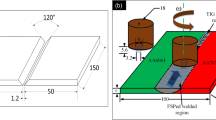Abstract
Process design and implementation in friction-stir welding (FSW) is mostly dependent on empirical information. Basic science of FSW and processing can only be complete when fundamental interrelationships between the process control parameters and response variables and the resulting weld microstructure and properties are established to a reasonable extent. It is known that primary process control parameters such as tool rotation, translation rates, and forge axis force have complicated and interactive relationships to process-response variables such as peak temperature and time at temperature. Of primary influence on the other process-response parameters are temperature and its gradient in the deformation and heat-affected zones. Through a review of pertinent works in the literature and results from boundary condition experiments performed in precipitation-hardening aluminum alloys, this article partially elucidates the nature and effects of temperature transients caused by variation of thermal boundaries in FSW.













Similar content being viewed by others
References
R.S. Mishra and Z.Y. Ma, Mater. Sci. Eng. R Rep. 50, 1 (2005).
R.S. Mishra, Scripta Mater. 58, 325 (2008).
P.L. Threadgill, A.J. Leonard, H.R. Shercliff, and P.J. Withers, Int. Mater. Rev. 54, 49 (2009).
T.W. Eager, Weld. J. 74 (1995).
K.J. Colligan and R.S. Mishra, Scripta Mater. 58, 327 (2008).
C.H. Martens, U.S. patent 3282748 (1966).
S. Benavides, Y. Li, L.E. Murr, D. Brown, and J.C. McClure, Scripta Mater. 41, 809 (1999).
C.G. Rhodes, M.W. Mahoney, W.H. Bingel, and M. Calabrese, Scripta Mater. 48, 1451 (2003).
T.W. Nelson, R.J. Steel, and W.J. Arbegast, Sci. Technol. Weld. Join. 8, 283 (2003).
J.-Q. Su, T.W. Nelson, R. Mishra, and M. Mahoney, Acta Mater. 51, 713 (2003).
D.C. Hofmann and K.S. Vecchio, Mater. Sci. Eng. A 402, 234 (2005).
L. Fratini, G. Buffa, and R. Shivpuri, Int. J. Adv. Manuf. Technol. 43, 664 (2008).
M. Hosseini and H. Danesh Manesh, Mater. Des. 31, 4786 (2010).
T. Bloodworth (M.S. thesis, Vanderbilt University, 2009).
F. Rui-dong, S. Zeng-qiang, S. Rui-cheng, L. Ying, L. Hui-jie, and L. Lei, Mater. Des. 32, 1 (2011).
K.J. Colligan, U.S. patent 6516992 (11 February 2003).
F. Palm, U.S. patent 6793118 (21 September 2004).
S. Kou and G. Cao, U.S. patent 7078647 (18 July 2006).
G. Kohn, Y. Greenberg, I. Makover, and A. Munitz, Weld. J. 81, 46 (2002).
B. M. Tweedy, W. Arbegast, and C. Allen (Paper presented the 2005 TMS Annual Meeting on Friction Stir Welding and Processing III, 2005), pp. 97–104.
P.C. Sinclair, W.R. Longhurst, C.D. Cox, D.H. Lammlein, A.M. Strauss, and G.E. Cook, Mater. Manufact. Proc. 25, 1283 (2010).
A.H. Lotfi and S. Nourouzi, Int. J. Adv. Manuf. Technol. 73, 1717 (2014).
M.J.C. Rosales, N.G. Alcantara, J. Santos, and R. Zettler, Mater. Sci. Forum 636–637, 459 (2010).
P. Su, A. Gerlich, T.H. North, and G.J. Bendzsak, Sci. Technol. Weld. Join. 11, 163 (2006).
D. Bakavos and P.B. Prangnell, Sci. Technol. Weld. Join. 14, 443 (2009).
Y.S. Sato, M. Urata, and H. Kokawa, Metall. Mater. Trans. A 33, 625 (2002).
P. Upadhyay and A.P. Reynolds, Mater. Sci. Eng. A 527, 1537 (2010).
P. Upadhyay and A.P. Reynolds, Mater. Sci. Eng. A 558, 394 (2012).
M. Moore (M.S. thesis, University of South Carolina, 2007).
P. Upadhyay and A. Reynolds, Metall. Mater. Trans. A 45, 2091 (2014).
D. Rosenthal, Weld. J. 20, 220 (1941).
Acknowledgements
The authors acknowledge the financial support of the Center for Friction Stir Processing, which is a National Science Foundation I/UCRC program (Grant No. EEC-0437341). The authors thank Dr. Wei Tang and Daniel Wilhelm, Department of Mechanical Engineering, University of South Carolina, Columbia, SC, for their help in preparing the weld joints.
Author information
Authors and Affiliations
Corresponding author
Rights and permissions
About this article
Cite this article
Upadhyay, P., Reynolds, A.P. Thermal Management in Friction-Stir Welding of Precipitation-Hardened Aluminum Alloys. JOM 67, 1022–1031 (2015). https://doi.org/10.1007/s11837-015-1381-0
Received:
Accepted:
Published:
Issue Date:
DOI: https://doi.org/10.1007/s11837-015-1381-0




